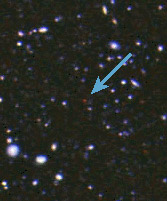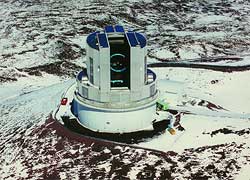|
MONTHLY NEWS Subaru Telescope Finds Furthest Galaxy | ||||||||||||
Hawaii's Mount Mauna Kea is a favorite spot for professional astronomers. More than a dozen observatories sit atop the mountain, vying for the best view of the heavens. But when it comes to good "eyesight," nothing quite beats the Subaru telescope. Subaru, one of the world's biggest optical-infrared telescopes, has a giant mirror that is 8.2 meters in diameter and collects even the faintest light in the night sky. In November 2003, the National Astronomical Observatory of Japan announced that Subaru had successfully identified seven galaxies in the far reaches of outer space. Among them was a galaxy more than 12.8 billion light years away from earth, the most distant galaxy discovered to date.
This new galaxy beat by three million light years a record Subaru itself set in March 2003. So far, Subaru has found nine of the ten farthest galaxies known to humankind. Light travels approximately 300,000 kilometers per second. That's seven and a half times around the earth in just one second! One light year is the distance light travels in a year, about 9.5 trillion (9,500,000,000,000) kilometers. Even at this dizzying speed, it took 12.8 billion years for light coming from the galaxy discovered by Subaru to reach Earth. In other words, Subaru is seeing these galaxies as they were 12.8 billion years ago. Since the universe is about 13.7 billion years old, Subaru is giving us a glimpse of how things were 900 million years after our universe was born.
Most scientists think the universe originated in the big bang - an explosion that eventually led to the creation of galaxies, stars, planets, and life. At first, there was one hot space where elementary particles flew around - the stage astronomers call the Dark Ages of the universe. Galaxies like the Milky Way, where the Earth is located, were formed only after the universe cooled down as it expanded. Determining when the Dark Ages ended is crucial in unraveling the story of how life began. The universe is still expanding, and galaxies and other celestial objects are speeding away from the Earth in all directions. Faraway objects move faster and emit light of a particular wavelength, enabling astronomers to distinguish them from closer objects. Imagine how the siren from an ambulance sounds different as it moves closer or recedes into the distance, and you get the idea. Astronomers at Subaru used a special filter that allows only light from galaxies more than 12.5 billion light years away to pass through. They found and photographed the galaxies by attaching the filter to the wide-range Suprime-Cam (Subaru Prime Focus Camera). Now they are trying to give Subaru an even sharper eye so that it can detect the first galaxies born after the big bang. Stay tuned as Subaru closes in on the origins of life, the universe, and everything! |
 |


